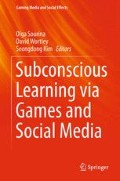Abstract
Games are the new form of storytelling and social interaction for younger generation. It might be surprising, but children are ready to do more work for their game characters than what they are ready to do for themselves. Because of this, we started to develop methods to enable user-generated character behaviours for educational games. In this paper, we show how user-generated behaviours can be recorded and shared in educational games. Furthermore, we demonstrate how user-generated behaviours can provide teachers and parents very detailed information about individual child’s learning process.
Access this chapter
Tax calculation will be finalised at checkout
Purchases are for personal use only
References
Baekkelund, C. (2006). Academic AI research and relations with the game industry. In S. Rabin (Ed.), AI game programming wisdom 3 (pp. 77–88). Massachusettes: Charles river Media Inc.
Biswas, G., Leelawong, K., Schwartz, D., & Vye, N. (2005). Learning by teaching: A new agent paradigm for educational software. Applied Artificial Intelligence, 19(3–4), 363–392.
Brusilovsky, P. (2001). Adaptive hypermedia. User Modeling and User-Adapted Interaction, 11, 87–110.
Cowling, P. (2006). Writing AI as sport. In S. Rabin (Ed.), AI game programming wisdom 3 (pp. 89–96). Massachusettes: Charles river Media Inc.
Dukovska, S. C., & Percinkova, B. (2011). A model that presents the states of consciousness of self and others. International Journal of Mathematical Models and Methods in Applied Sciences, 5(3), 602–609.
Hietala, P., & Niemenrepo, T. (1998). The competence of learning companion agents. International Journal of Artificial Intelligence in Education, 9, 178–192.
Houlette, R. (2003). Player modeling for adaptive games. In S. Rabin (Ed.), AI game programming wisdom II. Massachusetts: Charles River Media Inc.
Ketamo, H. (2011). Sharing behaviors in games and social media. International Journal of Applied Mathematics and Informatics, 5(1), 224–232.
Ketamo, H., Nurmi, C., & Kallama, K. (2011). User generated AI in sports education. In Proceedings of the 5th European Conference on Games Based Learning, Athens, Greece (pp. 306–314), October 20–21, 2011.
Ketamo, H., & Kiili, K. (2010). Conceptual change takes time: Game based learning cannot be only supplementary amusement. Journal of Educational Multimedia and Hypermedia, 19(4), 399–419.
Ketamo, H., & Suominen, M. (2010). Learning-by-teaching in an educational game: The educational outcome, user experience and social networks. Journal of Interactive Learning Research, 21(1), 75–94.
Ketamo, H. (2010). User generated AI’s for sport games: Framework with semantic networks. In J. Wiemeyer & S. Göbel (Eds.), Serious Games for Sports and Health: Proceedings of GameDays 2010, Darmstadt, Germany (pp. 77–90), March 25–26, 2010.
Ketamo, H. (2009). Semantic networks-based teachable agents in an educational game. Transactions on Computers, 8(4), 641–650.
Ketamo, H., & Multisilta, J. (2003). Towards adaptive learning materials: Speed of interaction and relative number of mistakes as indicators of learning results. Education and Information Technologies, 8(1), 55–66.
Kiili, K., & Ketamo, H. (2007). Exploring the learning mechanism in educational games. Journal of Computing and Information Technology, 15(4), 319–324.
Kumar, S., & Mastorakis, N. E. (2010). Novel models for multi-agent negotiation based semantic web service composition. WSEAS Transactions on Computers, 9(4), 339–350.
Liden, L. (2003). Artificial stupidity: The art of intentional mistakes. In S. Rabin (Ed.), AI game programming wisdom II. Massachusetts: Charles River Media Inc.
Mayer, R. (2004). Should there be a three-strikes rule against pure discovery learning? American Psychologist, 59, 14–19.
Popirlan, C. I. (2010). Knowledge processing in contact centers using a multi-agent architecture. WSEAS Transactions on Computers, 9(11), 1318–1327.
Scott, B. (2002). The illusion of intelligence. In S. Rabin (Ed.), AI game programming wisdom (pp. 16–20). Massachusetts: Charles River Media Inc.
Shoham, Y., & Leyton-Brown, K. (2009). Multiagent systems: Algorithmic, game-theoretic, and logical foundations. New York: Cambridge University Press.
Vogt, P. (2005). The emergence of compositional structures in perceptually grounded language games. Artificial Intelligence, 167, 206–242.
Vosniadou, S. (1994). Capturing and modelling the process of conceptual change. Learning and Instruction, 4, 45–69.
Author information
Authors and Affiliations
Corresponding author
Editor information
Editors and Affiliations
Rights and permissions
Copyright information
© 2015 Springer Science+Business Media Singapore
About this chapter
Cite this chapter
Ketamo, H. (2015). User-Generated Character Behaviors in Educational Games. In: Sourina, O., Wortley, D., Kim, S. (eds) Subconscious Learning via Games and Social Media. Gaming Media and Social Effects. Springer, Singapore. https://doi.org/10.1007/978-981-287-408-5_5
Download citation
DOI: https://doi.org/10.1007/978-981-287-408-5_5
Published:
Publisher Name: Springer, Singapore
Print ISBN: 978-981-287-407-8
Online ISBN: 978-981-287-408-5
eBook Packages: EngineeringEngineering (R0)

